<dependencies>
<dependency>
<groupId>org.springframework</groupId>
<artifactId>spring-webmvc</artifactId>
<version>5.2.20.RELEASE</version>
</dependency>
<dependency>
<groupId>org.springframework</groupId>
<artifactId>spring-jdbc</artifactId>
<version>5.3.24</version>
</dependency>
</dependencies>一、简介

1、Spring简介

2. 优点
3. 组成
4. 拓展
使用一个set接口实现,已经发生了革命性的变化。举例:
public interface UserDao {
void getUser();
}public class UserDaoImpl implements UserDao{
@Override
public void getUser() {
System.out.println("获得用户信息");
}
}public class UserDaoMysqlImpl implements UserDao{
@Override
public void getUser() {
System.out.println("获得mysql用户信息");
}
}public interface UserService {
void getUser();
}public class UserServiceImpl implements UserService{
private UserDao userDao;
public void setUserDao(UserDao userDao) {
this.userDao = userDao;
}
@Override
public void getUser() {
userDao.getUser();
}
}测试:
@Test
public void test2(){
UserServiceImpl userService = new UserServiceImpl();
userService.setUserDao(new UserDaoImpl());
userService.getUser();
userService.setUserDao(new UserDaoMysqlImpl());
userService.getUser();
}运行结果:

之前程序时主动创建对象,控制权在程序员手上;使用了set注入后,程序不再具有主动性,而是变成了被动的接收对象!从本质上解决了问题,程序员不用再去管理对象的创建,系统的耦合性大大降低,可以更加专注在业务实现上。这是IOC的原型。

二、IOC本质

三、举例入门
spring文档:Core Technologies (spring.io)
package com.wlp.pojo;
public class Hello {
private String str;
public String getStr() {
return str;
}
public void setStr(String str) {
this.str = str;
}
@Override
public String toString() {
return "hello: "+ str;
}
}文档1.2.1中复制以下配置语句,命名为bean.xml:(可以随意命名,没有要求)
<?xml version="1.0" encoding="UTF-8"?>
<beans xmlns="http://www.springframework.org/schema/beans"
xmlns:xsi="http://www.w3.org/2001/XMLSchema-instance"
xsi:schemaLocation="http://www.springframework.org/schema/beans
https://www.springframework.org/schema/beans/spring-beans.xsd">
<!-- 使用Spring来创建对象,在Spring这些都成为Bean
类型 变量名 = new 类型();
Hello hello = new Hello();
id = 变量名
class = new 的对象;
property 相当于给对象中的属性设置一个值!
property中的 name 为变量名,value为具体属性值,ref 引用容器中创建好的对象
这个过程就叫做控制反转
-->
<bean id="hello" class="com.wlp.pojo.Hello">
<property name="str" value="Spring"/> Hello类中有个叫str的属性
</bean>
</beans>测试类:
import org.springframework.context.ApplicationContext;
import org.springframework.context.support.ClassPathXmlApplicationContext;
public class MyTest {
public static void main(String[] args) {
//Spring容器:获取Spring的上下文对象!
ApplicationContext context = new ClassPathXmlApplicationContext("beans.xml");
//目前,对象都在Spring中管理了,如果要使用,直接去里面取出来就可以。
Object hello = context.getBean("hello"); // 参数为bean的id
System.out.println(hello.toString());
}
}前两个为dao包中的类,第三个为service包中的类:
<bean id="userDaoImpl" class="com.wlp.dao.UserDaoImpl"/>
<bean id="mysqlImpl" class="com.wlp.dao.UserDaoMysqlImpl"/>
<bean id="UserServiceImpl" class="com.wlp.service.UserServiceImpl">
<!--
ref: 引用Spring容器中创建好的对象
value:具体的值,基本数据类型!
-->
<property name="userDao" ref="mysqlImpl"/>
</bean>
依赖注入:利用set进行注入,所以实体类中必须有set方法。
四、IOC创建对象的方式
1. 使用无参构造创建对象,默认!
无参构造器或者默认构造器时可以使用property的方法
<bean id="UserServiceImpl" class="com.wlp.service.UserServiceImpl">
<property name="userDao" ref="mysqlServiceImpl"/>
</bean>2. 假设要使用有参构造创建对象
(1)下标赋值
<bean id="user" class="com.wlp.pojo.User">
<constructor-arg index="0" value="wlp"/>
</bean>(2)通过类型创建(基本类型直接写,引用类型写全名)不建议使用
<bean id="user" class="com.wlp.pojo.User">
<constructor-arg type="java.lang.String" value="WQCR"/>
</bean>(3)直接通过参数名
<bean id="user" class="com.wlp.pojo.User">
<constructor-arg name="name" value="wlp"/>
</bean>总结:在配置文件加载的时候,容器中管理的对象就已经初始化了,即xml中所有的bean对象都被注册了,而不管用不用。
五、Spring配置
1. 别名
使用alias或者在bean中加标签属性“name”, name属性可以有多个属性值,多个属性值之间可以用逗号,分号,空格分开
<bean id="user" class="com.wlp.pojo.User" name=" ">
<constructor-arg name="name" value="wlp"/>
</bean>
<alias name="user" alias="myUser"/>2. Bean的配置
id:bean的唯一标识符,也就是相当于对象名;
class:bean 对象所对应的全限定名:包名+类型;
name:也是别名,而且name可以同时取多个别名;
3. import
这个import一般用于团队开发使用,它可以将多个配置文件导入合并为一个
假设,现在项目中有多个人开发,这三个人负责不同的类开发,不同的类需要注册在不同的bean中,我们可以利用import将所有人的beans.xml合并为一个总的!
- 张三
- 李四
- 王五
创建applicationContext.xml配置文件,用来统一管理不同开发人员创建的bean.xml文件:
<import resource="beans.xml">
<import resource="beans2.xml">
<import resource="beans3.xml">使用的时候,直接使用总的配置就可以,也就是:
//Spring容器:获取Spring的上下文对象!
ApplicationContext context = new ClassPathXmlApplicationContext("applicationContext.xml");六、DI依赖注入
1. 构造器注入
前面说过
2. set方式注入【重点】
依赖注入:Set注入!
依赖:bean对象的创建依赖于容器!
注入:bean对象中的所有属性,由容器来注入!
(1)环境搭建
复杂类型
//Address类
package com.wlp.pojo;
public class Address {
private String address;
public String getAddress() {
return address;
}
public void setAddress(String address) {
this.address = address;
}
@Override
public String toString() {
return "address : " + address;
}
}
//Student类
package com.wlp.pojo;
import java.util.List;
import java.util.Map;
import java.util.Properties;
import java.util.Set;
public class Student {
private String name;
private Address address;
private String[] books;
private List<String> hobbies;
private Map<String, String> card;
private Set<String> games;
private String wife;
private Properties info;
@Override
public String toString() {
return name + " \n" + address + " \n" + Arrays.toString(books) + " \n" + hobbies + " \n" + card + " \n" + games +
" \n" + wife + " \n" + info;
}
}(2)set注入配置
<bean name="address" class="com.wlp.pojo.Address">
<property name="address" value="上海长宁"/>
</bean>
<bean id="student" class="com.wlp.pojo.Student">
<property name="name" value="wlp"/> 普通注入
<property name="address" ref="address"/> bean注入
<property name="books">
<array>
<value>三国</value>
<value>西游</value>
<value>水壶</value>
<value>红楼</value>
</array>
</property>
<property name="card">
<map>
<entry key="身份证:" value="130000199010200990"></entry>
<entry key="工行卡:" value="62834950000199010200990"></entry>
</map>
</property>
<property name="games">
<set>
<value>消消乐</value>
<value>跳一跳</value>
</set>
</property>
<property name="hobbies">
<list>
<value>唱歌</value>
<value>跳舞</value>
<value>滑冰</value>
</list>
</property>
<property name="info">
<props>
<prop key="url">jdbc:mysql:3306</prop>
<prop key="name">root</prop>
<prop key="password">mysql</prop>
</props>
</property>
<property name="wife">
<null/>
</property>
</bean>
(3)测试真实对象
public class MyTest {
public static void main(String[] args) {
ApplicationContext context = new ClassPathXmlApplicationContext("bean.xml");
Student student = (Student) context.getBean("student");
System.out.println(student);
}
}3. 拓展方式注入
p标签和c标签:
<?xml version="1.0" encoding="UTF-8"?>
<beans xmlns="http://www.springframework.org/schema/beans"
xmlns:xsi="http://www.w3.org/2001/XMLSchema-instance"
xmlns:p="http://www.springframework.org/schema/p"
xmlns:c="http://www.springframework.org/schema/c"
xsi:schemaLocation="http://www.springframework.org/schema/beans
https://www.springframework.org/schema/beans/spring-beans.xsd http://www.springframework.org/schema/mvc https://www.springframework.org/schema/mvc/spring-mvc.xsd">
<!-- name + " " + address + " " + books + " " + hobbies + " " + card + " " + games + " " + wife + " " + info-->
<!-- p命名空间注入,可以直接注入属性的值:property-->
<bean id ="user" class="com.wlp.pojo.User" p:name="wlp" p:age="27"/>
<!-- c命名空间注入,可以通过构造器注入,constructor-args -->
<bean id="user" class="com.wlp.pojo.User" c:age="25" c:name="WQCR"/>
</beans>测试:
ApplicationContext context = new ClassPathXmlApplicationContext("bean.xml");
User user = context.getBean("user", User.class); //getBean中用了反射可以直接返回相应类,不再需要强转
System.out.println(user.toString());ring());注意点:
p命名和c命名空间不能直接使用,需要导入xml约束! (且不能同时)
xmlns:p="http://www.springframework.org/schema/p"
xmlns:c="http://www.springframework.org/schema/c"p对应的set方式注入;c对应的构造器注入。c命名时,在实体类中必须有有参构造器。
4. bean的作用域
(1)单例模式(Spring默认机制,多用于单线程,同一个bean,每次获取的都是同一个对象)(面试)
id="accountService" class="com.something.DefaultAccountService" scope="singleton"/>
(2)原型模式:每次从容器中get的时候,都会产生一个新对象!多用于多线程
id="accountService" class="com.something.DefaultAccountService" scope="prototype"/>
(3)其余的request、session、application,这些个只能在web开发中使用到
七、Bean的自动装配
自动装配是Spring满足bean依赖的一种方式!Spring会在上下文中自动寻找,并自动给bean装配属性!
在Spring中有三种装配的方式:
(1)在xml中显示地配置
(2)在java中显示地配置
(3)隐式地自动装配bean【重要】
1. ByName自动装配
<bean id="dog" class="com.wlp.pojo.Dog"/>
<bean id="cat" class="com.wlp.pojo.Cat"/>
<!-- byName:会自动在容器上下文中查找,和自己对象set方法后面的值对应的bean id-->
<bean id="people" class="com.wlp.pojo.People" autowire="byName">
<property name="name" value="wlp~"/>
</bean>2. ByType自动装配
<bean class="com.wlp.pojo.Dog"/>
<bean class="com.wlp.pojo.Cat"/>
<!-- byType:会自动在容器上下文中查找,和自己对象属性类型相同的bean-->
<bean id="people" class="com.wlp.pojo.People" autowire="byType">
<property name="name" value="wlp~"/>
</bean>小结:
-
byName的时候,需要保证所有的bean的id唯一,并且这个bean需要和自动注入的属性的set方法的值一致!
-
byType的时候,需要保证所有bean的class唯一,并且这个bean需要和自动注入的属性的类型一致!
3. 使用注解实现自动装配
jdk1.5支持的注解,Spring2.5就支持注解了!
使用注解须知:
-
导入约束。context的约束
-
开启注解的支持:<context:annotation-config/>
<?xml version="1.0" encoding="UTF-8"?>
<beans xmlns="http://www.springframework.org/schema/beans"
xmlns:xsi="http://www.w3.org/2001/XMLSchema-instance"
xmlns:context="http://www.springframework.org/schema/context"
xsi:schemaLocation="http://www.springframework.org/schema/beans
https://www.springframework.org/schema/beans/spring-beans.xsd
http://www.springframework.org/schema/context
https://www.springframework.org/schema/context/spring-context.xsd">
<!--开启注解的支持-->
<context:annotation-config/>
<bean id="dog" class="com.wlp.pojo.Dog"/>
<bean id="cat" class="com.wlp.pojo.Cat"/>
<bean id="people" class="com.wlp.pojo.People">
<property name="name" value="wlp~"/>
</bean>
</beans>实体类中注解为@Autowired
public class People {
// 如果显示定义了Autowired的required属性为false,说明这个对象可以为null,否则不允许为空
@Autowired(required = false)
private Dog dog;
@Autowired
private Cat cat;
private String name;
}@Autowired
- 直接在属性上使用即可!也可以在set方式上使用!
- 使用Autowired就可以不用编写set方法了,前提是这个自动装配的属性在IOC(Spring)容器中存在,且符合名字byName!
- 如果显示定义了Autowired的required属性为false,说明这个对象可以为null,否则不允许为空。
@Nullable 说明这个字段可以为null
如果@Autowired 自动装配的环境比较复杂,自动装配无法通过一个注解【@Autowired】完成的时候,可以使用@Qualifier(value="xxx")去配合@Autowired的使用,指定一个唯一的bean对象注入!
<bean id="dog222" class="com.wlp.pojo.Dog"/>
<bean id="cat3" class="com.wlp.pojo.Cat"/>
<bean id="people" class="com.wlp.pojo.People">
<property name="name" value="wlp~"/>
</bean>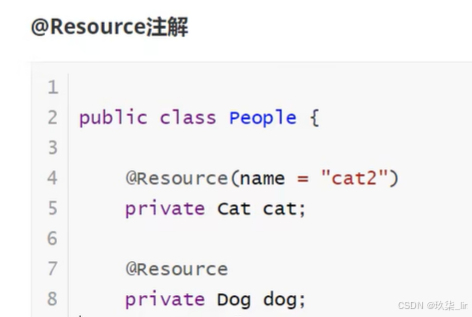
@Resource:
两种情况:① 保证有一个bean的id为实体类的名字;② 保证class的属性值指向的实体类唯一。
小结:
@Resource 和 @Autowired 的区别:
-
都是用来自动装配的,都可以放在属性字段上;
-
@Autowired 通过byType的方式实现,而且必须要求这个对象存在!【常用】
-
@Resource默认通过byName 的方式实现,如果找不到名字,则通过byType实现!如果两个都找不到的情况下,则报错!【常用】
-
执行顺序不同:@Autowired 通过byType的方式实现;@Resource默认通过byName 的方式实现
八、使用注解开发
1. bean
在Spring4之后,要使用注解开发,必须要保证aop包导入了
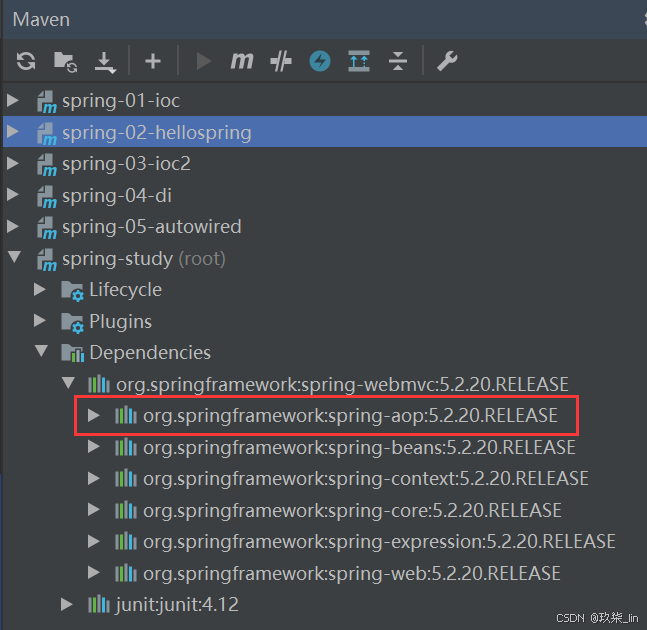
使用注解需要导入context约束,增加注解的支持!
<context:annotation-config/> 此约束适用于所有的注解,不管注解属不属于spring
<context:component-scan base-package="com.wlp.pojo"> 只适用于该包下的spring注解
2. 属性如何注入
@Component
public class User {
public String name;
// 相当于 <property name="name" value="wlp"/>
@Value("wlp")
public void setName(String name) {
this.name = name;
}
}3. 衍生的注解
@Component有几个衍生注解,在web开发中,会按照MVC三层架构分层!
- dao/mapper 【@Repository】
- service 【@Service】
- controller【@Controller】
这四个注解功能都一样,都是代表将某个类注册到Spring中,装配Bean。
4. 自动装配注解
注解说明:
@Autowired:自动装配通过 类型 -> 名字,如果@Autowired不能唯一自动装配上属性,则需要通过@Qualifier(value="xxx");
@Nullable:当字段标记了这个注解,说明该字段可以为null;
@Resource:自动装配,通过 名字 -> 类型
5. 作用域
@Component
@Scope("singleton")
public class User {
public String name;
// 相当于 <property name="name" value="wlp"/>
@Value("wlp")
public void setName(String name) {
this.name = name;
}
}6. 小结
xml 与 注解:
-
xml更加万能,适用于任何场合!维护更加简单方便
-
注解:不是自己的类就使用不了,维护相对复杂!
-
xml用来管理bean;
-
注解只负责完成属性的注入;
-
使用过程中只需要注意一个问题:必须让注解生效,需要开启注解的支持
<context:annotation-config/>
<!-- 指定要扫描的包,该包下的注解就会生效-->
<context:component-scan base-package="com.wlp"/>九、使用JavaConfig实现配置
使用注解配置方式创建容器。
新建实体类,在pojo目录下
//这里这个注解的意思是:该类被Spring接管了,注册到了容器中
@Component
public class User {
public String name;
public String getName() {
return name;
}
@Value("wlp") //属性注入值
public void setName(String name) {
this.name = name;
}
@Override
public String toString() {
return "User{" +
"name='" + name + '\'' +
'}';
}
}配置类:
//这个也是Spring容器托管,注册到容器中,因为他本来就是一个@Component
//@Configuration代表这是一个配置类,等同于之前的beans.xml
@Configuration
@ComponentScan("com.wlp.pojo") //扫描实体类所在的包
@Import(UserConfig2.class) //UserConfig2是User的另一个配置类,该类同样需要声明@Configuration, 通过@Import整合到UserConfig类中
public class UserConfig {
// 注册一个bean,就相当于之前写的一个bean标签
// 该方法的名字,就相当于bean标签中的id属性
// 该方法的返回值,就相当于bean标签中的class属性
@Bean
public User getUser() {
return new User(); //就是返回要注入到bean的对象!
}
}测试类:
public class MyTest {
public static void main(String[] args) {
// 如果完全使用了配置类方式去做,就只能通过 AnnotationConfig 上下文来获取容器,通过配置类的class对象加载!
AnnotationConfigApplicationContext context = new AnnotationConfigApplicationContext(UserConfig.class);
User getUser = context.getBean("getUser", User.class);
System.out.println(getUser.name);
}
}十、AOP
代理模式是SpringAOP的底层 【面试:SpringAOP 和 SpringMVC】
1. 静态代理
角色分析:
-
抽象角色:一般会使用接口或者抽象类来解决
-
真实角色:被代理的角色
-
代理角色:代理真实角色,代理真实角色后,一般会做一些附属操作
-
客户:访问代理对象的人!
代码步骤:
(1)接口
public interface User {
public void add();
public void delete();
public void update();
public void query();
}(2)真实角色
public class Service implements User {
public void add() {
System.out.println("增");
}
public void delete() {
System.out.println("删");
}
public void update() {
System.out.println("改");
}
public void query() {
System.out.println("查");
}
}(3)代理角色
public class Proxy implements User{
public Service serv;
public Proxy(Service serv) {
this.serv = serv;
}
public Service getServ() {
return serv;
}
public void setServ(Service serv) {
this.serv = serv;
}
public void add() {
log("add");
serv.add();
}
public void delete() {
log("delete");
serv.delete();
}
public void update() {
log("update");
serv.update();
}
public void query() {
log("query");
serv.query();
}
public void log(String msg){
System.out.println("调用了" + msg + "方法");
}
}(4)客户端访问代理角色
public class Client {
public static void main(String[] args) {
Service service = new Service();
Proxy proxy = new Proxy(service);
proxy.query();
}
}租房的例子:
public interface Rent {
public void rent();
}public class Host implements Rent {
public void rent() {
System.out.println("房东我要出租房子");
}
}public class Proxy implements Rent{
private Host host;
public Proxy(Host host) {
this.host = host;
}
public Host getHost() {
return host;
}
public void setHost(Host host) {
this.host = host;
}
public void rent(){
seeHouse();
host.rent();
contract();
fare();
}
public void seeHouse(){
System.out.println("看房子");
}
public void fare(){
System.out.println("收房租");
}
public void contract(){
System.out.println("签合同");
}
}public class Client {
public static void main(String[] args) {
Host host = new Host();
Proxy proxy = new Proxy(host);
proxy.rent();
}
}代理模式的好处:
-
可以使真实角色的操作更加纯粹!不用去关注一些公共的业务
-
公共业务就交给代理角色!实现了业务的分工!
-
公共业务发生扩展的时候,方便集中管理!
缺点:
-
一个真实角色就会产生一个代理角色;代码量会翻倍--开发效率降低。
2. 动态代理
-
动态代理和静态代理角色一样
-
动态代理的代理类是动态生成的,不是直接写好的
-
动态代理分为两大类:基于接口的动态代理,基于类的动态代理
需要了解两个类:Proxy:代理;InvocationHandler:调用处理程序
动态代理的好处:
-
可以使真实角色的操作更加纯粹,不用去关注一些公共的业务
-
公共业务就交给代理角色,实现了业务的分工!
-
公共业务发生拓展的时候,方便集中管理
-
一个动态代理类代理的是一个接口,一般就是对应的一类业务
-
一个动态代理类可以代理多个类,只要是实现了同一个接口即可
代理类:
//用该类 自动生成代理类!
public class ProxyInvocationHandler implements InvocationHandler {
// 被代理的接口
private Rent rent;
public void setRent(Rent rent) {
this.rent = rent;
}
// 生成得到代理类
public Object getProxy(){
return Proxy.newProxyInstance(
this.getClass().getClassLoader(),
rent.getClass().getInterfaces(), this);
}
// 处理代理实例,并返回结果
public Object invoke(Object proxy, Method method, Object[] args) throws Throwable{
// 动态代理的本质,就是使用反射机制实现!
seeHouse();
Object result = method.invoke(rent, args);
fare();
return result;
}
public void seeHouse(){
System.out.println("看房子");
}
public void fare(){
System.out.println("收中介费");
}
}客户类:
public class Client {
public static void main(String[] args) {
// 真实角色
Host host = new Host();
// 代理角色
ProxyInvocationHandler pih = new ProxyInvocationHandler();
// 通过调用程序处理角色来处理要调用的的接口对象!
pih.setRent(host);
Rent proxy = (Rent) pih.getProxy();
proxy.rent();
}
}自动生成代理类:
//用该类 自动生成代理类!
public class ProxyInvocationHandler implements InvocationHandler {
// 被代理的接口
private Object target;
public void setTarget(Object target) {
this.target = target;
}
// 生成得到代理类
public Object getProxy(){
return Proxy.newProxyInstance(
this.getClass().getClassLoader(),
target.getClass().getInterfaces(), this);
}
// 处理代理实例,并返回结果
public Object invoke(Object proxy, Method method, Object[] args) throws Throwable{
// 动态代理的本质,就是使用反射机制实现!
log(method.getName());
Object result = method.invoke(target, args);
return result;
}
public void log(String msg){
System.out.println("执行了" + msg + "方法");
}
}测试类:
public class Client {
public static void main(String[] args) {
Service service = new Service();
ProxyInvocationHandler pih = new ProxyInvocationHandler();
pih.setTarget(service);
User proxy = (User) pih.getProxy();
proxy.query();
}
}
十一、AOP
1. 什么是AOP
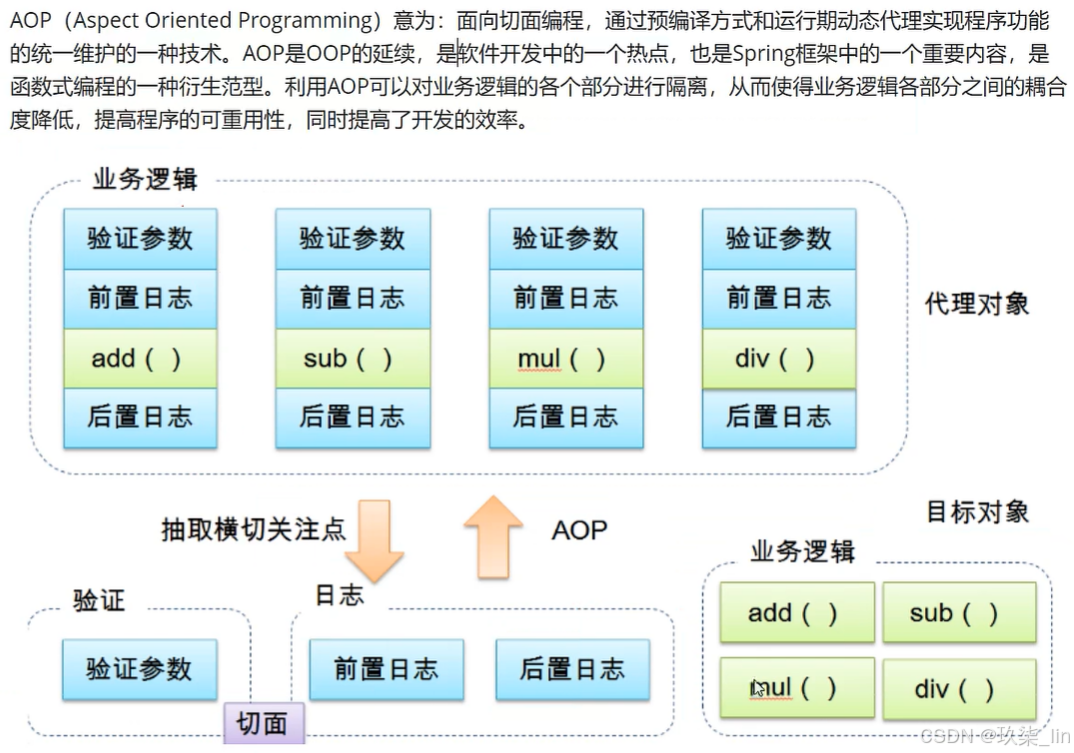
2. AOP在Spring中的作用
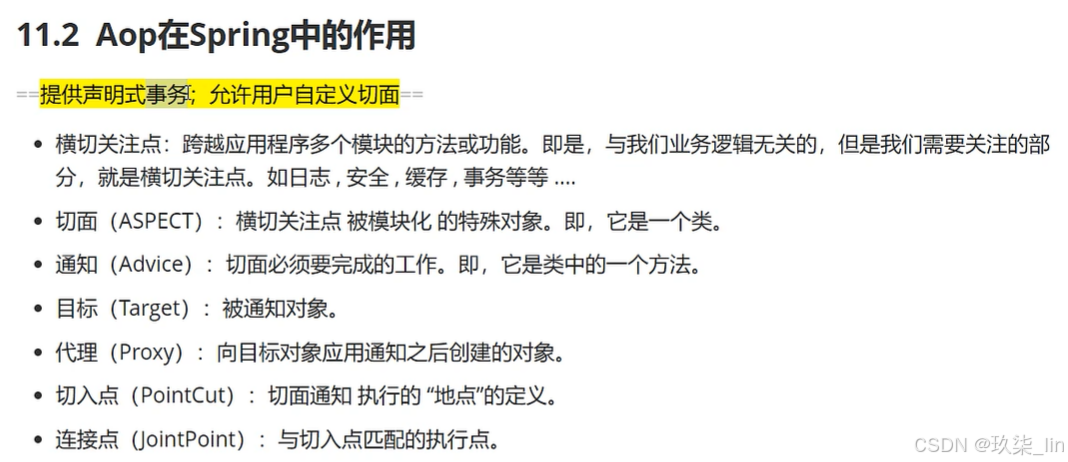
aop在不改变原有代码的情况下,去增加新的功能。
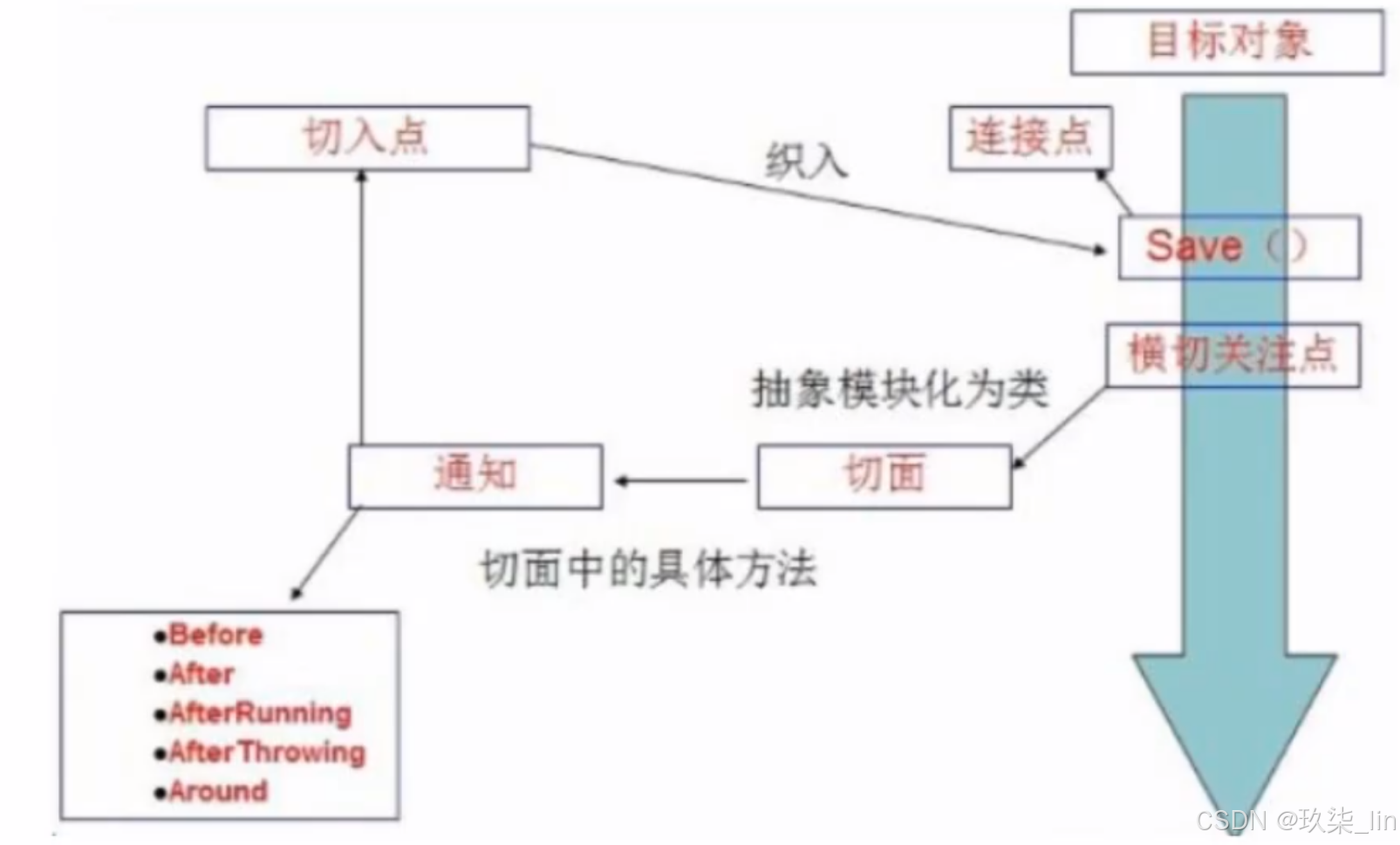
3. 使用Spring接口实现AOP
导入依赖
<dependency>
<groupId>org.aspectj</groupId>
<artifactId>aspectjweaver</artifactId>
<version>1.9.19</version>
</dependency>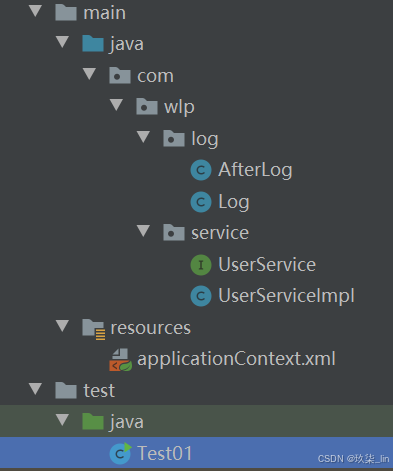
public interface UserService {
public void add();
public void del();
public void upd();
public void sel();
}public class UserServiceImpl implements UserService{
public void add() {
System.out.println("增");
}
public void del() {
System.out.println("删");
}
public void upd() {
System.out.println("改");
}
public void sel() {
System.out.println("查");
}
}public class Log implements MethodBeforeAdvice {
public void before(Method method, Object[] args, Object target) throws Throwable {
// method:要执行的目标对象的方法
// args:参数
// target:目标对象
System.out.println(target.getClass().getName() + "的" + method.getName()+"被执行了");
}
}public class AfterLog implements AfterReturningAdvice {
public void afterReturning(Object returnValue, Method method, Object[] args, Object target) throws Throwable {
System.out.println("执行了" + method.getName() + "方法,返回结果为:" + returnValue);
}
}<?xml version="1.0" encoding="UTF-8"?>
<beans xmlns="http://www.springframework.org/schema/beans"
xmlns:xsi="http://www.w3.org/2001/XMLSchema-instance"
xmlns:p="http://www.springframework.org/schema/p"
xmlns:c="http://www.springframework.org/schema/c"
xmlns:aop="http://www.springframework.org/schema/aop"
xsi:schemaLocation="http://www.springframework.org/schema/beans
https://www.springframework.org/schema/beans/spring-beans.xsd
http://www.springframework.org/schema/mvc
https://www.springframework.org/schema/mvc/spring-mvc.xsd
http://www.springframework.org/schema/aop
https://www.springframework.org/schema/aop/spring-aop.xsd">
<bean id="log" class="com.wlp.log.Log"/>
<bean id="afterLog" class="com.wlp.log.AfterLog"/>
<bean id="userServiceImpl" class="com.wlp.service.UserServiceImpl"/>
<!-- 方式一:使用原生Spring API接口-->
<!-- 配置aop:需要导入aop的约束-->
<aop:config>
<!-- 切入点:expression:表达式, execution(要执行的位置!* * * * * *)-->
<aop:pointcut id="pointcut" expression="execution(* com.wlp.service.UserServiceImpl.*(..))"/>
<!-- 执行环绕增强-->
<aop:advisor advice-ref="log" pointcut-ref="pointcut"/>
<aop:advisor advice-ref="afterLog" pointcut-ref="pointcut"/>
</aop:config>
</beans>public class NewTest {
public static void main(String[] args) {
ApplicationContext context = new ClassPathXmlApplicationContext("applicationContext.xml");
// 动态代理代理的是接口:UserService
UserService userServiceImpl = (UserService) context.getBean("userServiceImpl");
userServiceImpl.add();
}
}执行结果:

4. 自定义实现AOP【切面定义】
public class Diy {
public void before(){
System.out.println("首先输出的");
}
public void after(){
System.out.println("最后输出的");
}
}<!-- 方式二:自定义类-->
<bean id="diy" class="com.wlp.diy.Diy"/>
<aop:config >
<!-- 自定义切面,ref即要引用的类-->
<aop:aspect ref="diy">
<!-- 切入点-->
<aop:pointcut id="point" expression="execution(* com.wlp.service.UserServiceImpl.*(..))"/>
<!-- 通知-->
<aop:before method="before" pointcut-ref="point"/>
<aop:after method="after" pointcut-ref="point"/>
</aop:aspect>
</aop:config>5. 使用注解方式实现AOP
<!--方式三-->
<bean id="annotationPointcut" class="com.wlp.diy.AnnotationPointcut"/>
<!--开启注解支持-->
<aop:aspectj-autoproxy/>@Aspect //标注该类是一个切面
public class AnnotationPointcut {
@Before("execution(* com.wlp.service.UserServiceImpl.*(..))")
public void before(){
System.out.println("before");
}
@After("execution(* com.wlp.service.UserServiceImpl.*(..))")
public void after(){
System.out.println("after");
}
// 在环绕增强中,可以给定一个参数,代表要获取处理切入的点
@Around("execution(* com.wlp.service.UserServiceImpl.*(..))")
public void around(ProceedingJoinPoint jp) throws Throwable{
System.out.println("环绕前");
Signature signature = jp.getSignature(); //获得签名
System.out.println("signature:" + signature);
Object proceed = jp.proceed(); //执行方法
System.out.println("环绕后");
}
}运行结果:环绕前 方法执行前 方法执行 环绕后 方法执行后
十二、整合Mybatis
步骤:
(1)导入相关jar包
- junit
- mybatis
- mysql数据库
- spring相关的
- aop置入
- mybatis-spring
(2)编写配置文件
(3)测试
mybatis-spring:
<!-- mybatis整合spring -->
<dependency>
<groupId>org.mybatis</groupId>
<artifactId>mybatis-spring</artifactId>
<version>2.1.0</version>
</dependency>1. Mybatis-spring
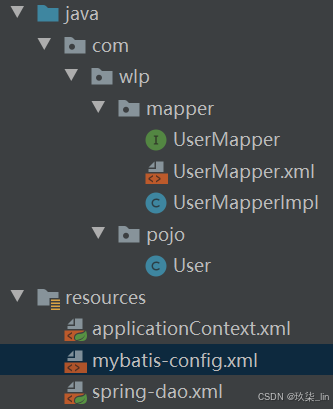
-
编写数据源配置
-
sqlSessionFactory
-
sqlSessionTemplate
-
需要给接口加实现类
-
将自己写的实现类,注入到Spring中
-
测试使用即可
user.java
@Data
public class User {
private int id;
private String name;
private String pwd;
}UserMapper接口
public interface UserMapper {
public List<User> getUser();
}UserMapper.xml
<?xml version="1.0" encoding="GBK" ?>
<!DOCTYPE mapper
PUBLIC "-//mybatis.org//DTD Config 3.0//EN"
"https://mybatis.org/dtd/mybatis-3-mapper.dtd">
<!--namespace绑定一个对应的mapper接口-->
<mapper namespace="com.wlp.mapper.UserMapper">
<select id="getUser" resultType="User">
select * from mybatis.user
</select>
</mapper>mybatis-config.xml
<?xml version="1.0" encoding="GBK" ?>
<!DOCTYPE configuration
PUBLIC "-//mybatis.org//DTD Config 3.0//EN"
"https://mybatis.org/dtd/mybatis-3-config.dtd">
<configuration>
<typeAliases>
<package name="com.wlp.pojo"/>
</typeAliases>
</configuration>spring-dao.xml:用spring管理数据源、sqlSessionFactory等
<?xml version="1.0" encoding="GBK"?>
<beans xmlns="http://www.springframework.org/schema/beans"
xmlns:xsi="http://www.w3.org/2001/XMLSchema-instance"
xmlns:p="http://www.springframework.org/schema/p"
xmlns:c="http://www.springframework.org/schema/c"
xmlns:aop="http://www.springframework.org/schema/aop"
xsi:schemaLocation="http://www.springframework.org/schema/beans
https://www.springframework.org/schema/beans/spring-beans.xsd
http://www.springframework.org/schema/mvc
https://www.springframework.org/schema/mvc/spring-mvc.xsd
http://www.springframework.org/schema/aop
https://www.springframework.org/schema/aop/spring-aop.xsd">
<!-- DataSource:使用Spring的数据源替代Mybatis的配置-->
<!-- 这里是用Spring提供的JDBC:org.springframework.jdbc.datasource-->
<bean id="dataSource" class="org.springframework.jdbc.datasource.DriverManagerDataSource">
<property name="driverClassName" value="com.mysql.jdbc.Driver"/>
<property name="url" value="jdbc:mysql://localhost:3306/mybatis?useSSL=false&useUnicode=true&characterEncoding=UTF-8"/>
<property name="username" value="root"/>
<property name="password" value="mysq123"/>
</bean>
<!-- sqlSessionFactory-->
<bean id="sqlSessionFactory" class="org.mybatis.spring.SqlSessionFactoryBean">
<property name="dataSource" ref="dataSource"/>
<!-- 绑定mybatis配置文件-->
<property name="configLocation" value="classpath:mybatis-config.xml"/>
<property name="mapperLocations" value="classpath:com/wlp/mapper/*.xml"/>
</bean> <!-- sqlSessionTemplate:就是使用的sqlSession-->
<bean id="sqlSession" class="org.mybatis.spring.SqlSessionTemplate">
<!-- 只能用构造器注入sqlSessionFactory, 因为它没有set方法-->
<constructor-arg index="0" ref="sqlSessionFactory"/>
</bean>
</beans>UserMapperImpl.java
public class UserMapperImpl implements UserMapper {
private SqlSessionTemplate sqlSession;
public void setSqlSession(SqlSessionTemplate sqlSession){
this.sqlSession = sqlSession;
}
public List<User> getUser(){
UserMapper mapper = sqlSession.getMapper(UserMapper.class);
return mapper.getUser();
}
}applicationContext.xml
<?xml version="1.0" encoding="GBK"?>
<beans xmlns="http://www.springframework.org/schema/beans"
xmlns:xsi="http://www.w3.org/2001/XMLSchema-instance"
xmlns:p="http://www.springframework.org/schema/p"
xmlns:c="http://www.springframework.org/schema/c"
xmlns:aop="http://www.springframework.org/schema/aop"
xsi:schemaLocation="http://www.springframework.org/schema/beans
https://www.springframework.org/schema/beans/spring-beans.xsd
http://www.springframework.org/schema/mvc
https://www.springframework.org/schema/mvc/spring-mvc.xsd
http://www.springframework.org/schema/aop
https://www.springframework.org/schema/aop/spring-aop.xsd">
<!--应用spring-dao.xml的配置-->
<import resource="spring-dao.xml"/>
<bean id="userMapper" class="com.wlp.mapper.UserMapperImpl">
<property name="sqlSession" ref="sqlSession"/>
</bean>
</beans>MyTest
public class MyTest {
public static void main(String[] args) {
ApplicationContext context = new ClassPathXmlApplicationContext("applicationContext.xml");
UserMapper userMapper = context.getBean("userMapper", UserMapper.class);
List<User> user = userMapper.getUser();
for (User user1 : user) {
System.out.println(user1);
}
}
}第二种方式:(不太建议使用)
新建UserMapperImpl2.java
public class UserMapperImpl2 extends SqlSessionDaoSupport implements UserMapper {
public List<User> getUser() {
UserMapper mapper = getSqlSession().getMapper(UserMapper.class);
return mapper.getUser();
}
}SqlSessionDaoSupport类要有单参构造器,需要注入一个SqlSessionFactory.

所以需要在以下配置文件中注入 SqlSessionFactory,其中ref来自于spring-dao.xml 中注册的SqlSessionFactory实例。
applicationContext.xml中
<bean id="userMapper2" class="com.wlp.mapper.UserMapperImpl2">
<property name="sqlSessionFactory" ref="sqlSessionFactory"/>
</bean>十三、声明式事务
1. 事务
把一组业务当成一个业务来做,要么都成功,要么都失败
事务在项目开发中十分重要,涉及到数据的一致性问题
确保完整性和一致性
事务ACID原则:
-
原子性
-
一致性
-
隔离性:多个业务可能操作同一个资源,防止数据损坏
-
持久性:事务一旦提交,无论系统发生什么问题,结果都不会被影响,被持久化写到存储器中
2. Spring中的事务管理
声明式事务:AOP
编程式事务:需要在代码中进行事务的管理
为什么需要事务:
如果不配置事务,可能存在数据提交不一致的情况;
如果不在Spring中去配置声明式事务,就需要在代码中手动配置事务
事务在项目开发中十分重要,涉及到数据的一致性和完整性问题
spring-dao.xml中配置
<!-- 结合AOP实现事物的置入-->
<!-- 配置事务的类;-->
<tx:advice id="txAdvice" transaction-manager="transactionManager">
<!-- 给哪些方法配置事务-->
<!-- 配置事务的传播特性:new propagation(默认就有)-->
<tx:attributes>
<!-- <tx:method name="add" propagation="REQUIRED"/>-->
<!-- <tx:method name="delete" propagation="REQUIRED"/>-->
<!-- <tx:method name="update" propagation="REQUIRED"/>-->
<!-- <tx:method name="query" read-only="true"/>-->
<tx:method name="*" propagation="REQUIRED"/>
</tx:attributes>
</tx:advice>
<!-- 配置事务切入-->
<aop:config>
<aop:pointcut id="txPointCut" expression="execution(* com.wlp.mapper.*.*(..))"/>
<aop:advisor advice-ref="txAdvice" pointcut-ref="txPointCut"/>
</aop:config>案例:
user.java
@Data
@AllArgsConstructor
@NoArgsConstructor
public class User {
private int id;
private String name;
private String pwd;
}UserMapper接口
public interface UserMapper {
public List<User> getUser();
public int addUser(User user);
public int delUser(int id);
}UserMapper.xml
<?xml version="1.0" encoding="GBK" ?>
<!DOCTYPE mapper
PUBLIC "-//mybatis.org//DTD Config 3.0//EN"
"https://mybatis.org/dtd/mybatis-3-mapper.dtd">
<!--namespace绑定一个对应的mapper接口-->
<mapper namespace="com.wlp.mapper.UserMapper">
<select id="getUser" resultType="User">
select * from mybatis.user
</select>
<insert id="addUser" parameterType="user">
insert into mybatis.user values(#{id}, #{name}, #{pwd})
</insert>
<delete id="delUser">
deletes from mybatis.user where id = #{id}
</delete>
</mapper>mybatis-config.xml
<?xml version="1.0" encoding="GBK" ?>
<!DOCTYPE configuration
PUBLIC "-//mybatis.org//DTD Config 3.0//EN"
"https://mybatis.org/dtd/mybatis-3-config.dtd">
<configuration>
<typeAliases>
<package name="com.wlp.pojo"/>
</typeAliases>
</configuration>spring-dao.xml
需要在文件头中加入:
xmlns:tx="http://www.springframework.org/schema/tx"
http://www.springframework.org/schema/tx
https://www.springframework.org/schema/tx/spring-tx.xsd<?xml version="1.0" encoding="GBK"?>
<beans xmlns="http://www.springframework.org/schema/beans"
xmlns:xsi="http://www.w3.org/2001/XMLSchema-instance"
xmlns:tx="http://www.springframework.org/schema/tx"
xmlns:c="http://www.springframework.org/schema/c" xmlns:aop="http://www.springframework.org/schema/aop"
xmlns:cache="http://www.springframework.org/schema/cache"
xsi:schemaLocation="http://www.springframework.org/schema/beans
https://www.springframework.org/schema/beans/spring-beans.xsd
http://www.springframework.org/schema/tx
https://www.springframework.org/schema/tx/spring-tx.xsd
http://www.springframework.org/schema/aop
https://www.springframework.org/schema/aop/spring-aop.xsd http://www.springframework.org/schema/cache http://www.springframework.org/schema/cache/spring-cache.xsd">
<!-- DataSource:使用Spring的数据源替代Mybatis的配置-->
<!-- 这里是用Spring提供的JDBC:org.springframework.jdbc.datasource-->
<bean id="dataSource" class="org.springframework.jdbc.datasource.DriverManagerDataSource">
<property name="driverClassName" value="com.mysql.jdbc.Driver"/>
<property name="url" value="jdbc:mysql://localhost:3306/mybatis?useSSL=false&useUnicode=true&characterEncoding=UTF-8"/>
<property name="username" value="root"/>
<property name="password" value="mysq123"/>
</bean>
<!-- sqlSessionFactory-->
<bean id="sqlSessionFactory" class="org.mybatis.spring.SqlSessionFactoryBean">
<property name="dataSource" ref="dataSource"/>
<!-- 绑定mybatis配置文件-->
<property name="configLocation" value="classpath:mybatis-config.xml"/>
<property name="mapperLocations" value="classpath:com/wlp/mapper/*.xml"/>
</bean>
<!-- sqlSessionTemplate:就是使用的sqlSession-->
<bean id="sqlSession" class="org.mybatis.spring.SqlSessionTemplate">
<!-- 只能用构造器注入sqlSessionFactory, 因为它没有set方法-->
<constructor-arg index="0" ref="sqlSessionFactory"/>
</bean>
<!-- 配置声明式事务-->
<bean id="transactionManager" class="org.springframework.jdbc.datasource.DataSourceTransactionManager">
<property name="dataSource" ref="dataSource"/>
</bean>
<!-- 结合AOP实现事物的置入-->
<!-- 配置事务的类;-->
<tx:advice id="txAdvice" transaction-manager="transactionManager">
<!-- 给哪些方法配置事务-->
<!-- 配置事务的传播特性:new propagation(默认就有)-->
<tx:attributes>
<!-- <tx:method name="add" propagation="REQUIRED"/>-->
<!-- <tx:method name="delete" propagation="REQUIRED"/>-->
<!-- <tx:method name="update" propagation="REQUIRED"/>-->
<!-- <tx:method name="query" read-only="true"/>-->
<tx:method name="*" propagation="REQUIRED"/>
</tx:attributes>
</tx:advice>
<!-- 配置事务切入-->
<aop:config>
<aop:pointcut id="txPointCut" expression="execution(* com.wlp.mapper.*.*(..))"/>
<aop:advisor advice-ref="txAdvice" pointcut-ref="txPointCut"/>
</aop:config>
</beans>applicationContext.xml
<?xml version="1.0" encoding="GBK"?>
<beans xmlns="http://www.springframework.org/schema/beans"
xmlns:xsi="http://www.w3.org/2001/XMLSchema-instance"
xmlns:p="http://www.springframework.org/schema/p"
xmlns:c="http://www.springframework.org/schema/c"
xmlns:aop="http://www.springframework.org/schema/aop"
xsi:schemaLocation="http://www.springframework.org/schema/beans
https://www.springframework.org/schema/beans/spring-beans.xsd
http://www.springframework.org/schema/mvc
https://www.springframework.org/schema/mvc/spring-mvc.xsd
http://www.springframework.org/schema/aop
https://www.springframework.org/schema/aop/spring-aop.xsd">
<import resource="spring-dao.xml"/>
<bean id="userMapper" class="com.wlp.mapper.UserMapperImpl">
<property name="sqlSessionFactory" ref="sqlSessionFactory"/>
</bean>
</beans>UserMapperImpl.java
public class UserMapperImpl extends SqlSessionDaoSupport implements UserMapper {
// private SqlSessionTemplate sqlSession;
// public void setSqlSession(SqlSessionTemplate sqlSession){
// this.sqlSession = sqlSession;
// }
public List<User> getUser(){
User user = new User(2, "fgff999f", "hfjahlfa");
UserMapper mapper = getSqlSession().getMapper(UserMapper.class);
mapper.addUser(user); mapper.delUser(3);
return mapper.getUser();
}
public int addUser(User user) {
UserMapper mapper = getSqlSession().getMapper(UserMapper.class);
return mapper.addUser(user);
}
public int delUser(int id) {
UserMapper mapper = getSqlSession().getMapper(UserMapper.class);
return mapper.delUser(id);
}
}测试类:
public class MyTest {
public static void main(String[] args) {
ApplicationContext context = new ClassPathXmlApplicationContext("applicationContext.xml");
UserMapper userMapper = context.getBean("userMapper", UserMapper.class);
List<User> user = userMapper.getUser();
for (User user1 : user) {
System.out.println(user1);
}
}
}

























 被折叠的 条评论
为什么被折叠?
被折叠的 条评论
为什么被折叠?








